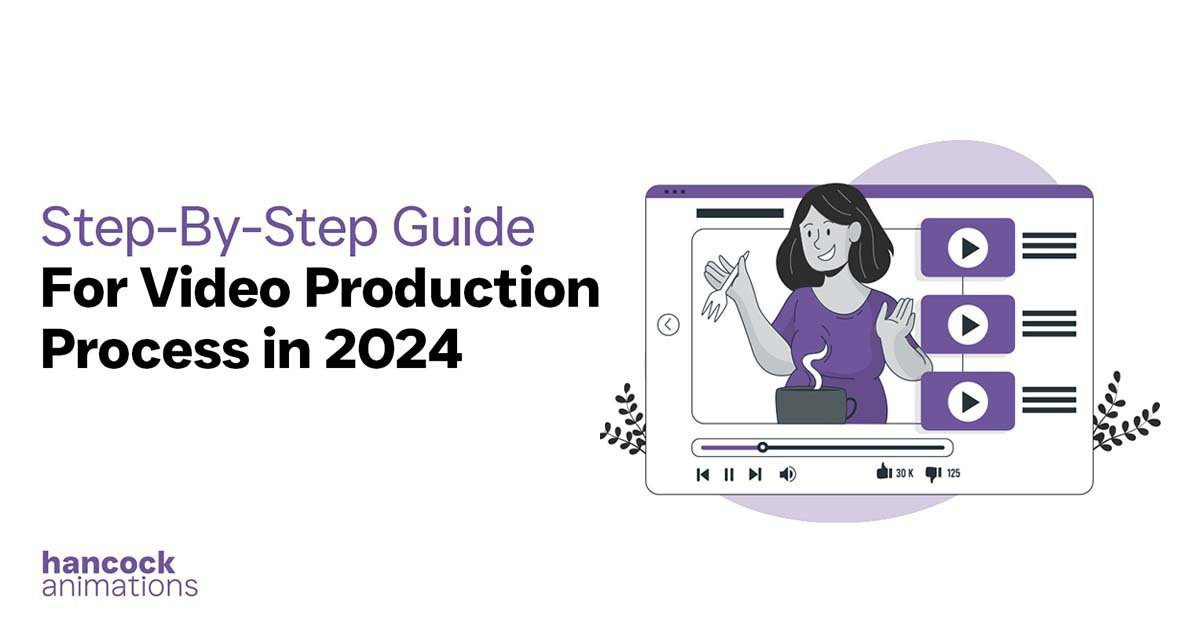A Step-By-Step Guide For Video Production Process In 2024

In today’s world, where everything is digitized, creating any sort of video content, be it a promo, a film, or just a podcast, requires skills and those skills are hidden within your video production process.
However, it’s crucial to acknowledge that you’ll encounter various obstacles along the way, which can be mitigated through informed decisions and, in some cases, by partnering with an experienced video production company.
Whether you decide to hire professional video production services or produce the video on your own, you must understand the video production best practices for optimal results. So, to help you, Hancock Animations has come up with a complete step-by-step guide on the video production process.

What is Video Production?
Video production is the process of creating video content, typically for a variety of purposes, including entertainment, information, marketing, education, and more. It involves a series of organized steps, from concept development and pre-production planning to filming or recording, post-production editing, and distribution. Video production encompasses a wide range of content, including movies, television shows, documentaries, advertisements, corporate videos, online content, and more.
Video production is the process of creating video content, typically for a variety of purposes, including entertainment, information, marketing, education, and more. It involves a series of organized steps, from concept development and pre-production planning to filming or recording, post-production editing, and distribution. Video production encompasses a wide range of content, including movies, television shows, documentaries, advertisements, corporate videos, online content, and more.
Importance of Video Production
Imagine a world without the magic of moving images – where stories remain untold, products unseen, and messages unheard. Such a world seems unfathomable today, thanks to the pivotal role that video production plays in our lives. From the silver screen to the smartphone screen, video production has evolved into a medium of unparalleled influence.
But what makes video production more than just a tool, but an art form with profound implications for how we communicate and engage with the world?
The following key points highlight the importance of video production:
- Video is a powerful medium for conveying messages, stories, and information.
- High-quality video production can captivate and hold the viewer’s attention, making it an excellent tool for marketing, education, and entertainment.
- Videos can effectively promote and showcase a brand’s products, services, values, and personality.
- Videos encourage viewer engagement through likes, shares, comments, and calls to action.
- Video production is versatile and can be tailored to various purposes, including marketing campaigns, training modules, product demonstrations, storytelling, and more.
- They can simplify complex concepts, demonstrate processes, and enhance learning experiences in diverse fields such as academia, corporate training, and e-learning.
- Video production allows storytellers to convey narratives in a visually compelling way.
- In the digital age, video content can be easily shared and accessed globally.
- Analytics tools provide valuable insights into how viewers interact with video content.
- High-quality video production can set businesses and creators apart from competitors.

3 Stages of the Video Production Process
The process of producing a video is divided into three crucial stages: pre-production, production, and post-production. The steps are elaborated below:
Pre-production in Video Production
The initial stage of making a video is all about getting everything ready and includes everything from when you decide to create a video to actually filming it.
During this pre-production phase, there are six important steps that you must follow. Completing each task in this phase will make your video shoot successful, even if you are not present at the location yourself, like most of the episodes of the famous show “Game of Thrones”.
1. Preparing The Video Strategy
- Start by figuring out the main purpose of your video. Why are you creating it in the first place? Whether it’s to let more people know about your brand or to get more people interested, every part of making the video should clearly convey this main idea and help you achieve your goal.
- Learn about your viewers. Who will be watching the video? Collect all the information about the people you want to reach, the issues they want help with, and what kind of videos they usually enjoy. This way, you can make a video that they will like and that will help you meet your video goal at the same time.
- Plan out your finances and schedule a shoot day. Decide on a reasonable budget and timeline, and make sure not to cut corners on production expenses. It is better not to release a video than to release one with poor quality!
2. Content and Planning
- What makes your video stand out? While focusing on your video goal, figure out how you want to make it interesting and decide what to put into the video.
- Create your script. The script can be flexible depending on the type of video you’re making. For example, if it is a video podcast, you just need a list of topics to cover in your conversation or interview to keep it natural and smooth. You can either write your own script or outsource professional scriptwriting services to produce a compelling and successful video.
- Make a storyboard. This helps you see your video in pictures and plan the various shots you will need when you start filming in the next phase.
- Decide who and what you require. Develop a schedule for production that includes lists of the people, locations, and items you’ll need to record these shots.
3. Pick a Location
Look at your video goal and storyboard to find and lock down the locations you need to convey your story. Also, be prepared for any problems that might come up. For instance, if you are shooting outdoors, have a backup plan if it starts raining!
For videos where your host is just talking to the camera, choose a quiet, well-lit room to make sure you get the best audio and visuals if they have a spot where they feel comfortable filming.
4. Finalize Talent
Depending on the goals of your video, looking for talent consists of many different ways:
- If you’re filming a scripted story with actors, then you need to recruit professionals with good acting skills.
- If you’re recording a video testimonial or a how-to, this step means asking your happy customers or employees to talk about their experience on record.
- Video podcasts involve finding and inviting guests to interview and discuss some of the hot topics.
For good video production, it is crucial that the people in your video convey your main idea and help you achieve your goal. So, do not forget to explain to them why you are creating the video, what it is about, and what you expect from this video project.
5. Getting the Equipment
The primary equipment you will need for your video-making process is a decent high-performance camera, microphone, and lighting.
There is a wide variety to choose from, depending on how much you are willing to spend. You can also find places that rent out video gear, which lets you use much better equipment than actually buying it.
The extra equipment you need will depend on what your video is about. This includes props, furniture, etc. So be sure to check your production schedule list for reference. Or you can simply hire a video production company and let them bring their own equipment.

6. Scheduling Shoot Date
Based on your timeline and when your talent and location are available, plan out when you will film your video. Once you have finalized the shoot schedule, all you have to do is inform your team and the talent about the date and align everything for the shoot.
Production Process in Video Production
The production process in video production is a pivotal phase where creative concepts come to life. It’s the heart of the entire filmmaking journey, encompassing the most essential step and task. Let’s explore the production process in video production:
7. The Shoot Day
This stage involves:
- Setting up your equipment.
- Doing a rehearsal to ensure everything goes smoothly and everyone is ready to start shooting.
- Lastly, filming the video.
Everything you have done in the previous steps of the video production process has led to this ultimate moment. Create a checklist to make sure you have covered all your bases.
Depending on the type of video you are making, this phase might also include things like capturing extra footage, interviewing guests, creating animations, and recording voiceovers.
Also, keep your video goal in mind and refer back to the storyboard you made in step two while you shoot your video.
You can also hire a professional video production company like Hancock Animations and save yourself from all the hustle.
Post-production in Video Production
The final phase of making a video is called post-production. During this phase, your project goes from the raw video footage to a finished, polished video that is ready to share. Post-production involves:
8. Editing the Video
Editing your video involves picking the best scenes, removing any unnecessary parts, and arranging them to create a video that is of the right length and contains only the important content.
If you are not interested in learning how to edit the video yourself, then you can hire professional video editing services from Hancock Animations, and let us take care of this post-production work for you.
9. Color Grading
Colorists adjust the video’s color and tone to achieve a consistent and visually appealing look.
10. Visual Effects (VFX) in Video Production
If necessary, visual effects are added to the video during this phase, ranging from simple enhancements to complex CGI.
11. Music and Sound Design
Sound designers create and add sound effects to enhance the auditory experience, including ambiance, Foley, and more.
12. Distribution and Marketing
The final stage of the video post-production process is distributing and marketing your completed video. This involves uploading the video to your chosen hosting platform.
Once you pick the platform, it is time to promote your video across different platforms, websites, social media, and newsletters, or hire video marketing services to maximize your video’s reach and engagement, ultimately achieving the initial video goals set during the planning phase.
Wrapping Up….
Whether you’re a seasoned filmmaker, a business owner looking to promote your brand, or an aspiring content creator, understanding the intricate process of pre-production, production, and post-production is the key to unlocking the full potential of video as a transformative communication medium.
With this knowledge in hand, you can navigate the challenges, seize opportunities, and embark on a creative adventure that captivates, educates, and entertains in the ever-evolving landscape of digital media. So, whether you’re writing scripts, directing scenes, or fine-tuning the final edit, the video production process empowers you to turn visions into reality, one frame at a time.
Video production costs can vary significantly based on factors like video length, complexity, equipment, location, and personnel. On average, it can range from a few hundred dollars for a simple video to thousands or even more for high-end productions.
Cost factors include pre-production planning, scriptwriting, location fees, equipment rental, crew salaries, post-production editing, graphics, animations, and music licensing.
The timeline for video production depends on the video’s complexity and length. Simple videos can be produced in a few days, while more elaborate projects may take weeks or even months.
The video production strategy involves defining goals, identifying the target audience, creating a content plan, selecting the right format, scripting, production, editing, distribution, and analysis. It’s a structured approach to ensure the video aligns with the overall marketing or communication strategy.
Virtually all industries can benefit from video production. Common sectors include marketing, entertainment, education, healthcare, real estate, manufacturing, and nonprofit organizations.
Success can be measured through key performance indicators (KPIs) like view counts, engagement rates, click-through rates, conversions, and social shares. Analyzing these metrics helps assess the impact of your video on your objectives.

